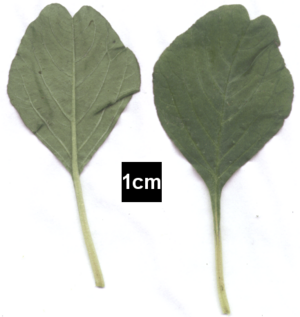Mediterranean amaranth facts for kids
Quick facts for kids Mediterranean amaranth |
|
|---|---|
 |
|
| Leaves | |
| Scientific classification | |
| Genus: |
Amaranthus
|
| Species: |
graecizans
|
Amaranthus graecizans, also known as the Mediterranean amaranth or short-tepalled pigweed, is a type of plant that lives for only one year. It belongs to the plant family called Amaranthaceae. You can find this plant growing naturally in many parts of the world, including Africa, southern Europe, East Asia, India, and Central Asia. It has also started growing in North America, even though it wasn't originally from there. Some common names for this plant are tumbleweed and pigweed.
What is Mediterranean Amaranth?
How it Looks
The Mediterranean amaranth is a plant that grows from a seed, flowers, produces seeds, and then dies all within one year. It can grow up to about 50 centimeters (almost 20 inches) tall. Its stems branch out from the bottom and can be smooth or have tiny, curly hairs.
The flowers of this plant are special because each flower is either male or female, not both. They are yellow and produce small, round, black seeds that are about 1 to 1.25 millimeters wide.
Where it Grows
Amaranthus graecizans likes to grow in warm places. You can find it in areas with a mild climate, even high up in mountains, sometimes as high as 2,400 meters (about 7,874 feet). It grows very quickly after it rains. This plant often appears in disturbed areas, like near places where people or animals live. It also likes sandy, flat areas that get flooded sometimes during the year.
How People Use It
The leaves of the Mediterranean amaranth are safe to eat and are used as a vegetable in many parts of Africa and the Middle East. People can eat the leaves raw, but they are more often cooked. They are also added to sauces and stews to make them taste better.
One common way to cook Amaranthus graecizans is to boil it in buttermilk. Another way is to squeeze fresh lime juice over the cooked leaves. The seeds of this plant are also full of starch, which means they can be eaten too.
It's important to know that no plants in the Amaranthus family are known to be poisonous. However, if these plants grow in soil that has a lot of nitrogen, especially from fertilizer, they can store a lot of nitrates in their leaves. This is something to be aware of, but generally, the plant is safe to eat.
See also
 In Spanish: Amaranthus graecizans para niños
In Spanish: Amaranthus graecizans para niños

